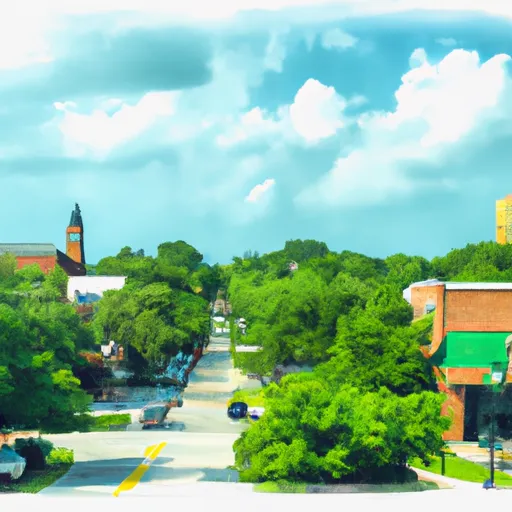-
 Snoflo Premium
Snoflo Premium
Get unlimited access to all our content
With no Ad interruptions! - Start Your Free Trial Login with existing account
Summerville
Eden Index
Climate
7.6
•
Recreation
3.8
•
Community
2.1
•
Safeguard
4.9/10

Summerville, Georgia is a charming town located in Chattooga County in the northwestern part of the state. Known for its scenic beauty and mild climate, Summerville offers a pleasant outdoor experience for residents and visitors alike.
The climate in Summerville is classified as humid subtropical, characterized by hot and humid summers and mild winters. Summers are typically warm with temperatures averaging in the 80s Fahrenheit, while winters are mild with temperatures rarely dropping below freezing. This makes Summerville an ideal destination for outdoor activities throughout the year.
As for hydrology constituents, Summerville is surrounded by picturesque landscapes, including the nearby Chattooga River. This river is a popular spot for fishing, kayaking, and rafting. The region also boasts several other water bodies, such as lakes and creeks, providing ample opportunities for boating, swimming, and other water-related activities.
In addition to its hydrological features, Summerville offers various outdoor recreation opportunities. The nearby Chattahoochee National Forest is a haven for hikers, campers, and nature enthusiasts, with numerous trails showcasing the area's stunning flora and fauna. Additionally, the region is home to several parks and recreational areas perfect for picnicking, birdwatching, and enjoying the great outdoors.
Overall, Summerville, Georgia offers a delightful climate, beautiful waterways, and diverse outdoor recreation opportunities, making it an appealing destination for those seeking an outdoor adventure or a peaceful retreat in nature.
What is the Eden Index?
The Snoflo Eden Index serves as a comprehensive rating system for regions, evaluating their desirability through a holistic assessment of climate health, outdoor recreation opportunities, and natural disaster risk, acknowledging the profound impact of these factors on livability and well-being.
Climate Health Indicator (CHI): 7.6
Summerville receives approximately
1414mm of rain per year,
with humidity levels near 85%
and air temperatures averaging around
16°C.
Summerville has a plant hardyness factor of
7, meaning
plants and agriculture in this region tend to thrive during the non-winter months.
By considering the ideal temperature range, reliable water supplies, clean air, and stable seasonal rain or snowpacks, the Climate Health Indicator (CHI) underscores the significance of a healthy climate as the foundation for quality living.
A healthy climate is paramount for ensuring a high quality of life and livability in a region, fostering both physical well-being and environmental harmony. This can be characterized by ideal temperatures, reliable access to water supplies, clean air, and consistent seasonal rain or snowpacks.
Weather Forecast
Streamflow Conditions
Coosa-Tallapoosa
Area Rivers
Coosa-Tallapoosa
Snowpack Depths
Coosa-Tallapoosa
Reservoir Storage Capacity
Coosa-Tallapoosa
Groundwater Levels
Recreational Opportunity Index (ROI): 3.8
The Recreational Opportunity Index (ROI) recognizes the value of outdoor recreational options, such as parks, hiking trails, camping sites, and fishing spots, while acknowledging that climate plays a pivotal role in ensuring the comfort and consistency of these experiences.
Access to outdoor recreational opportunities, encompassing activities such as parks, hiking, camping, and fishing, is crucial for overall well-being, and the climate plays a pivotal role in enabling and enhancing these experiences, ensuring that individuals can engage in nature-based activities comfortably and consistently.
Camping Areas
| Campground | Campsites | Reservations | Toilets | Showers | Elevation |
|---|---|---|---|---|---|
| Spring Villa Campground | 24 | 604 ft | |||
| LakePoint State Park | 192 | 208 ft | |||
| John Tanner State Park | None | 1,094 ft | |||
| R Shaefer Heard | None | 640 ft | |||
| Tally Valley County Park | None | 1,117 ft | |||
| Chewacla State Park | None | 516 ft | |||
| Amity | None | 689 ft | |||
| Whitetail Ridge | None | 694 ft | |||
| Burnt Village | 120 | 687 ft | |||
| Pyne Road Park | 24 | 711 ft |
Nearby Fishing
Nearby Ski Areas
Catastrophe Safeguard Index (CSI):
The Catastrophe Safeguard Index (CSI) recognizes that natural disaster risk, encompassing floods, fires, hurricanes, and tornadoes, can drastically affect safety and the overall appeal of an area.
The level of natural disaster risk in a region significantly affects safety and the overall livability, with climate change amplifying these risks by potentially increasing the frequency and intensity of events like floods, fires, hurricanes, and tornadoes, thereby posing substantial challenges to community resilience and well-being.
Community Resilience Indicator (CRI): 2.1
The Community Resilience Indicator (CRI) recognizes that education, healthcare, and socioeconomics are crucial to the well-being of a region. The CRI acknowledges the profound impact of these elements on residents' overall quality of life. By evaluating educational resources, healthcare accessibility, and economic inclusivity, the index captures the essential aspects that contribute to a thriving community, fostering resident satisfaction, equity, and social cohesion.

